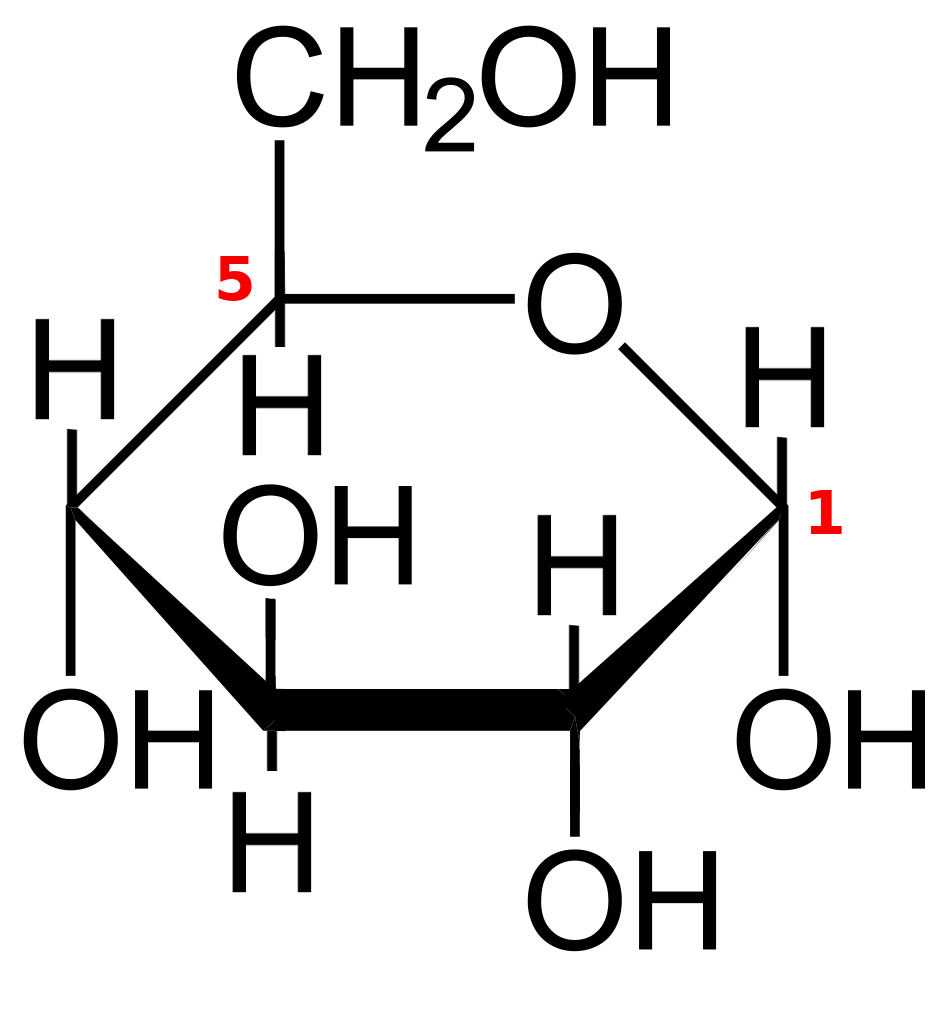
Which monosaccharide forms cellulose?
A. Beta D Glucose
B. Alpha D Galactose
C. Beta D Fructose
D. Alpha D Fructose
Answer
364.5k+ views
Hint: Carbohydrates are an important part of our diet; natural sources of carbohydrates include grains, fruits, and vegetables. Carbohydrates supply energy to the body, particularly glucose, a simple sugar found in starch and found in a variety of everyday foods. Carbohydrates play a variety of roles in humans, animals, and plants.
Complete answer:
Glucose is made up of two isomers of the aldohexose sugars, one of which (D-glucose) is physiologically active. L-glucose, the mirror counterpart of D-glucose, cannot be utilised by cells. The open-chain form of glucose (either 'D-' or 'L-') is in equilibrium in solutions with many cyclic isomers, each of which contains a ring of carbons closed by one oxygen atom.
There are two types of D-glucose: alpha-D-glucose and beta-D-glucose. Only the direction in which the -H and -OH groups point to carbon 1 differs. Starch is generated when alpha-glucose molecules are chemically bonded to create a polymer. When beta-glucose molecules are linked together to create a polymer, the result is cellulose.

Sucrose is made up of two monomers α-D-Glucose and β-D-Fructose.
Cellulose made up of β -D-Glucose.
Starch made up of α-D-Glucose.
Lactose is made up of two monomers β-D-Galactose and β-D-Glucose.
So, the correct answer is A. β -D-Glucose.
The stoichiometric formula for carbohydrates is ($CH_2O$)n, where n is the number of carbons in the molecule. In other words, the carbon-to-hydrogen-to-oxygen ratio in carbohydrate molecules is 1:2:1. This formula also explains how the term "carbohydrate" came to be: the components are carbon ("carbo") and water (thus "hydrate"). Monosaccharides, disaccharides, and polysaccharides are the three forms of carbohydrates.
The notation 'a-' indicates that the hydroxyl group linked to C-1 and the -$CH_2OH$ group at C-5 are on opposing sides of the ring's plane (a trans arrangement), whereas 'ß-' indicates that they are on the same side of the plane (a cis arrangement).
Cellulose, the other primary glucose polysaccharide present in plants, has a structural rather than a nutritive function. One of the most abundant organic substances in the biosphere is cellulose. Each year, a lot of cellulose is generated and destroyed on Earth. It's a non-branched polymer made up of glucose residues linked together by -1,4 links.
Note:-
The covalent chemical links that connect ring-shaped sugar molecules to other molecules are known as glycosidic bonds. They can be O-linked or N-linked because they are formed by a condensation process between an alcohol or amine from one molecule and the anomeric carbon of the sugar.
Complete answer:
Glucose is made up of two isomers of the aldohexose sugars, one of which (D-glucose) is physiologically active. L-glucose, the mirror counterpart of D-glucose, cannot be utilised by cells. The open-chain form of glucose (either 'D-' or 'L-') is in equilibrium in solutions with many cyclic isomers, each of which contains a ring of carbons closed by one oxygen atom.
There are two types of D-glucose: alpha-D-glucose and beta-D-glucose. Only the direction in which the -H and -OH groups point to carbon 1 differs. Starch is generated when alpha-glucose molecules are chemically bonded to create a polymer. When beta-glucose molecules are linked together to create a polymer, the result is cellulose.

Sucrose is made up of two monomers α-D-Glucose and β-D-Fructose.
Cellulose made up of β -D-Glucose.
Starch made up of α-D-Glucose.
Lactose is made up of two monomers β-D-Galactose and β-D-Glucose.
So, the correct answer is A. β -D-Glucose.
The stoichiometric formula for carbohydrates is ($CH_2O$)n, where n is the number of carbons in the molecule. In other words, the carbon-to-hydrogen-to-oxygen ratio in carbohydrate molecules is 1:2:1. This formula also explains how the term "carbohydrate" came to be: the components are carbon ("carbo") and water (thus "hydrate"). Monosaccharides, disaccharides, and polysaccharides are the three forms of carbohydrates.
The notation 'a-' indicates that the hydroxyl group linked to C-1 and the -$CH_2OH$ group at C-5 are on opposing sides of the ring's plane (a trans arrangement), whereas 'ß-' indicates that they are on the same side of the plane (a cis arrangement).
Cellulose, the other primary glucose polysaccharide present in plants, has a structural rather than a nutritive function. One of the most abundant organic substances in the biosphere is cellulose. Each year, a lot of cellulose is generated and destroyed on Earth. It's a non-branched polymer made up of glucose residues linked together by -1,4 links.
Note:-
The covalent chemical links that connect ring-shaped sugar molecules to other molecules are known as glycosidic bonds. They can be O-linked or N-linked because they are formed by a condensation process between an alcohol or amine from one molecule and the anomeric carbon of the sugar.
Recently Updated Pages
Glucose when reduced with HI and red Phosphorus gives class 11 chemistry CBSE

The highest possible oxidation states of Uranium and class 11 chemistry CBSE

Find the value of x if the mode of the following data class 11 maths CBSE

Which of the following can be used in the Friedel Crafts class 11 chemistry CBSE

A sphere of mass 40 kg is attracted by a second sphere class 11 physics CBSE

Statement I Reactivity of aluminium decreases when class 11 chemistry CBSE

Trending doubts
The reservoir of dam is called Govind Sagar A Jayakwadi class 11 social science CBSE

10 examples of friction in our daily life

What problem did Carter face when he reached the mummy class 11 english CBSE

Difference Between Prokaryotic Cells and Eukaryotic Cells

State and prove Bernoullis theorem class 11 physics CBSE

Proton was discovered by A Thomson B Rutherford C Chadwick class 11 chemistry CBSE




